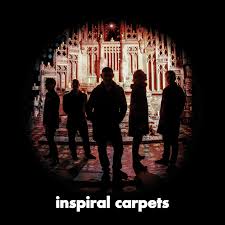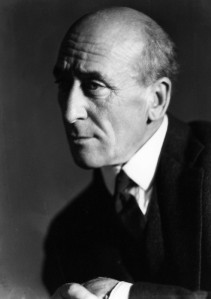Inspiral Carpets
What do you do when an old friend turns up asking to restart a relationship after a twenty year break? Is it possible to pick up where you left off? What on earth could you still have in common?
These were the questions that faced me when a new album by the Inspiral Carpets turned up, unlooked for, on my radar a few months ago. Here again were my very favourite band from my late teens and early twenties, asking me to pick up where we left off.
I truly loved the Inspiral Carpets. Of all the Madchester bands of the late eighties and early nineties they were the ones who really did it for me, providing pure pop pleasures in a chart awash with the cynical pop by numbers of Stock, Aitken and Waterman and their endless imitators.
True, the Carpets were never particularly cool despite their ‘Cool as Fuck’ slogan (if you have to insist on it, you are not cool), they looked as ugly as sin with their Peter Tork hairdos and ridiculous baggy clothing, and possessed neither the style of the Stone Roses or the street urchin charms of the Happy Mondays. Yet that was precisely what endeared them to me as a decidedly non-cool schoolboy with preposterous hair and bad clothing: they were simply my band.
Their music was brilliantly alive and curiously unique: all gothic organ shapes, hyperactive drums, minimalist guitar, grinding bass and honking singing. Their songs oozed hooks and instantly hummable melodies – once heard an Inspiral Carpets single is almost impossible to dislodge from your auditory memory centres.
They were also successful – seventeen UK charting singles in five years, four of them top twenty. Their four albums, Life, The Beast Inside, The Revenge of the Goldfish and Devil Hopping, all top twenty releases, with three making the top ten.
They were the first band I saw live, at the SECC in Glasgow in 1990 and again at the Queen’s Hall in Edinburgh in 1992. I can attest that they were an excellent live band and impressed me with a wonderful psychedelic light show years before I even knew what psychedelia was.
Then in 1994 they suddenly stopped, calling it a day after delivering Devil Hopping, the evergreen sixties-worshipping single ‘Saturn 5’ and the Mark E Smith destroyed ‘I Want You’. I was disappointed at the time because I thought the album was brilliant, something of a recovery from the uneven Revenge of the Goldfish, and I wanted to see where they could take it to next.
As time passed I suppose I felt grateful that they had thrown in the towel. My musical tastes were maturing quickly and I was discovering all sorts of music that made the Inspirals seem a bit, well, lightweight. Their demise meant they slipped away with dignity and honour, allowing me to retain a fond memory of their work. In my mind they settled gently into the category marked ‘Lower League Band – Good Fun But Never Contenders’.
And there they might have stayed if they had not come knocking at my door once again, looking to rekindle the love affair.
So, what are they like after twenty years? I’m looking at the band photo. I’ve mentioned already that they were an ugly band and time has not been altogether kind, although their hair, or what is left of it, is a great deal less embarrassing. I suppose I shouldn’t mock: I am, after all, older and uglier too.
The main difference I notice is the absence of Tom Hingley, the lead singer. I understand that he and the rest of the band have had something of a parting of the ways and he has been replaced on vocals for this new outing by Stephen Holt.
Curiously, Stephen Holt is a founding member of the band, who helped get the group together back in 1983 with guitarist Graham Lambert. He left in 1989 during the writing of debut album Life to found The Rainkings, and was replaced by Tom Hingley just as the Inspirals found critical and commercial success. So in essence the Carpets have come full circle to their original line-up with a singer who quit twenty-six years previously.
In the run-up to the release of the new album the band re-mastered and re-released the legendary (amongst Carpets fans) album of demos and works in progress known as Dung 4, previously only available as a roughly recorded tape cassette. This album features original versions of a few of the songs that were to be included on debut album Life, sung by Stephen Holt before his departure. In their more familiar finished versions all of these songs were re-recorded with Tom Hingley on vocals.
It is a strange experience hearing these familiar songs sung by an unfamiliar voice, but as you listen it becomes clear why the band decided to make these recordings more widely available. Stephen Holt and Tom Hingley actually have remarkably similar singing styles, the main difference being that Hingley has a much more powerful voice than Holt. That they use similar phrasings and have a similar range must have made Hingley an ideal replacement in 1989, meaning that the songs already written would not need to be extensively re-written to accommodate a singer with a different style.
The re-release of this material makes the point that it was Holt and not Hingley who helped develop the original sound and that he is an intrinsic part of the early bands DNA. It also serves as a reminder of their rough and ready garage roots, a world away from their slick and polished output of the nineties.
So, is the new album any good?
I must admit that as I slipped the CD into the music centre (CD for old times sake – it just felt wrong buying an Inspiral Carpets release as a digital download) I was worried that I would find my old favourite band something of an embarrassment, a collection of old men trying and failing to recapture old glories. With trembling and trepidation, I pressed play: two and a bit minutes later I was an excited eighteen year old all over again.
First song ‘Monochrome’ powers out of the speakers, galloping along on a monstrous and buzzing organ lick in much the same way as ‘Generations’ did from Revenge of the Goldfish, only this time with pointed lyrics that could actually mean something and which are probably a dig at Hingley and his autobiography Carpet Burns.
Next I am in pop heaven with ‘Spitfire’, surely the older brother of ‘Saturn 5’, a soaring tune of delightfully diving harmonies and exuberant choruses.
I am hooked from this point on and the album, simply called Inspiral Carpets, does not falter. ‘Flying Like a Bird’ sees them attempt something new with Beach Boys-like layered harmonies and softer textures, and sees them get away with it. ‘You’re So Good For Me’ is another killer tune and another permanent fixture in those auditory centres.
‘Forever Here’ sounds like a lost Charlatans song from back when the Charlatans still sounded like the Charlatans. ‘Let You Down’ successfully repeats the Mark E Smith trick by having punk poet John Cooper Clarke intone over a dark and claustrophobic tune. ‘A to Z of my Heart’ and ‘Calling Out to You’ weld intriguing lyrics to solid gold tunes. ‘Hey Now’ is a sprightly fifties referencing number and ‘Our Time’ could almost be a lost Carpets song from the late eighties kitted out with an infectious, sing-along chorus.
By the time epic closer ‘Human Shield’ melts away I want to go straight back to the start of the ride and take another turn. It is a blast – a fizzing, pounding, flying, uplifting, exuberant and joyous success of a record. I doubt if many bands half the age of the Carpets have as much energy as this.
The Inspirals really do seem to have recaptured their inspiration. Perhaps having Holt back in the fold has helped them to re-connect with their earlier garage incarnation and sent them back to first principles. The sound, and particularly Clint Boon’s haunted organ, is the original sound as heard on Dung 4 and the early EPs, allied with all the pop craft honed over those four previous albums.
Holt might not have as powerful a voice as Hingley, but he has a mellow, tuneful quality that carries the album with ease and presence. Graham Lambert’s guitar is as clever and minimal as ever; Martyn Walsh’s bass is as grinding and slippery as ever; and Craig Gill’s drums are as taught and precise as ever. Finally, Clint Boon’s organ playing is as wondrous a thing as it has ever been, finding those uniquely weird, gothic shapes that frame and propel the songs as only he is able.
The Carpets are definitely back: they may still not be as cool as fuck, but they are a real burst of energy and colour in these austere times. Perhaps I should have believed their new slogan – ‘Keep the Faith.’
To answer my original question: yes, it is possible to rekindle an old friendship after twenty years, if the things you once loved about that relationship still hold true for both of you.
In this case, it is as if the years had never passed.

